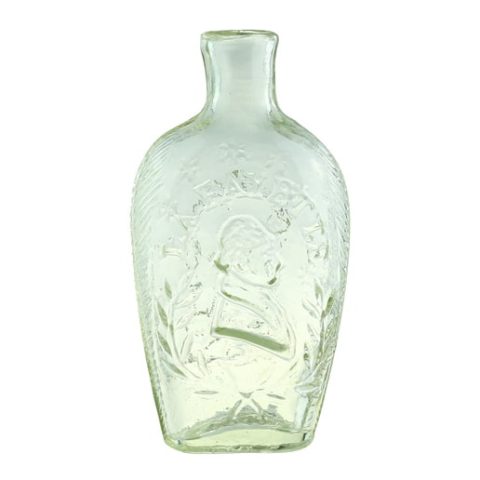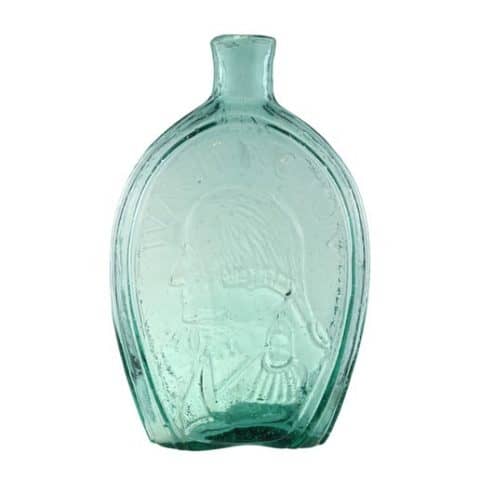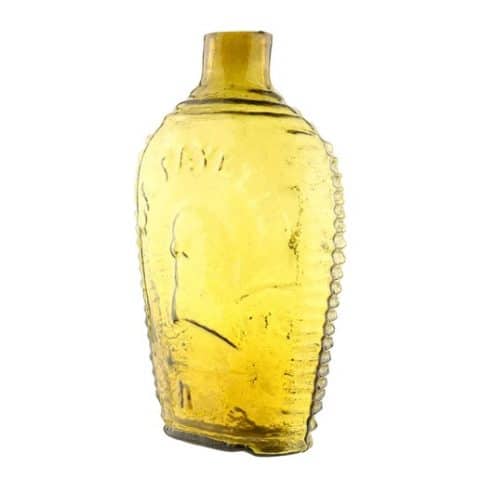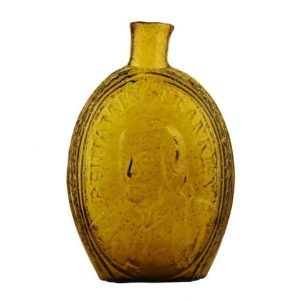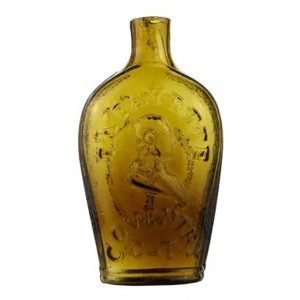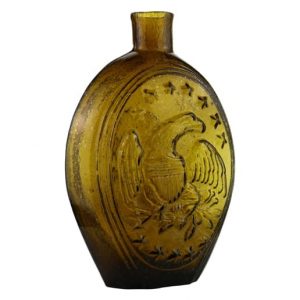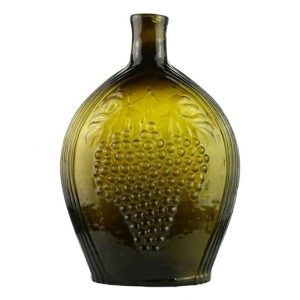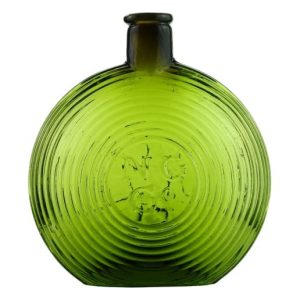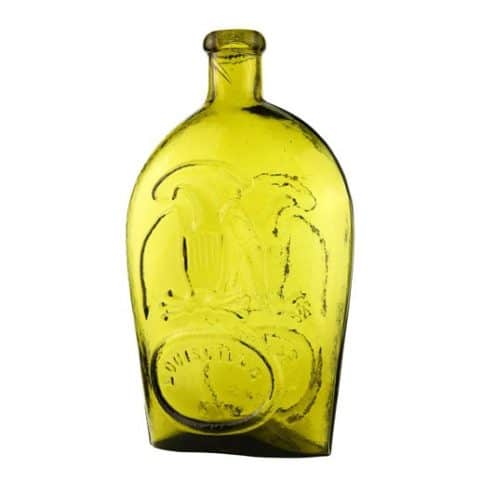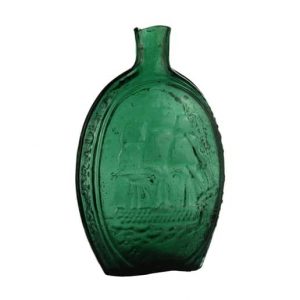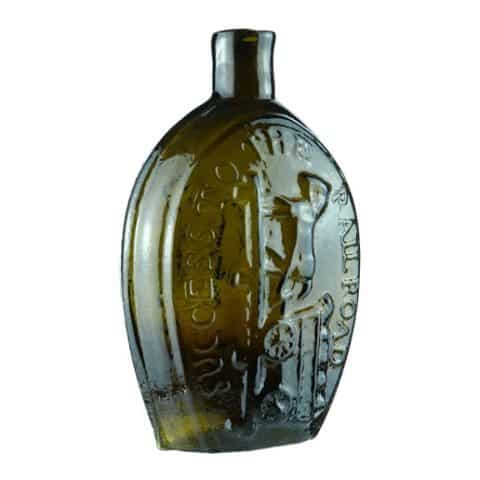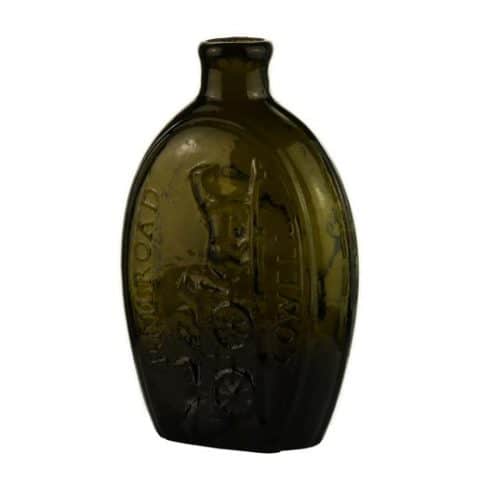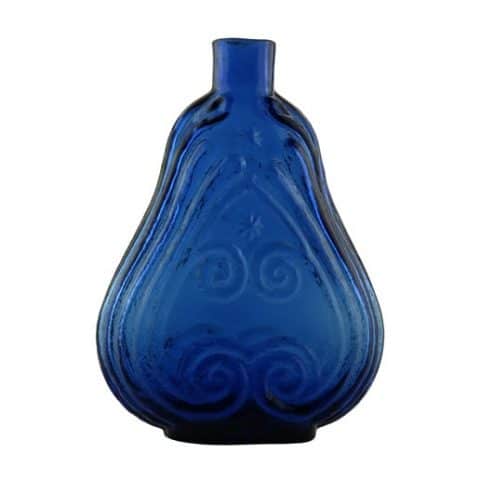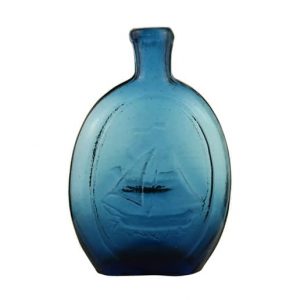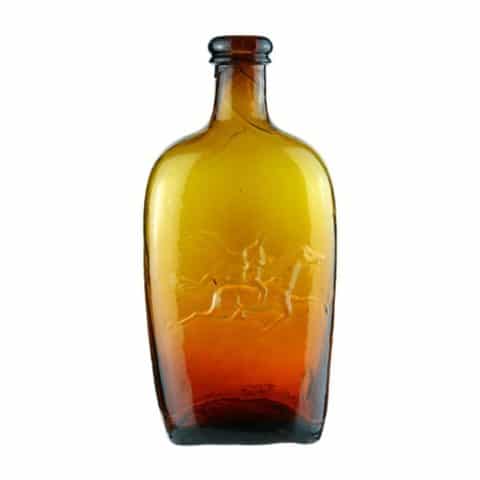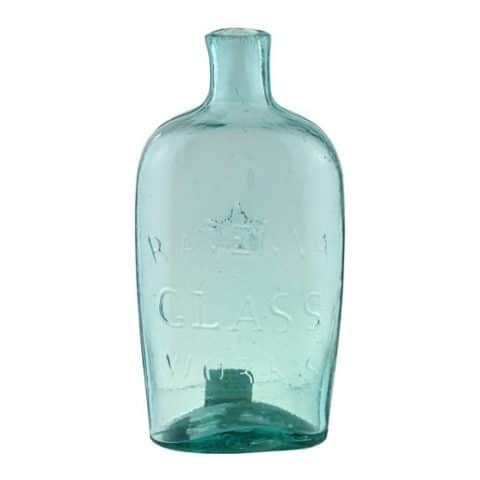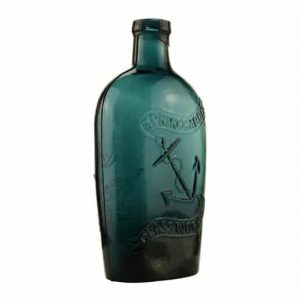GXIII-58 Anchor and “Spring Garden Glass Works” – Log Cabin Flask
GXIII – 58
Anchor And “Spring Garden / Glass Works” – Log Cabin
Historical Flask
Spring Garden Glass Works, Baltimore, Maryland
Prussian Blue Pint
Provenance: Anonymous

Our pint GXIII-58 “Spring Garden / Glass Works” and Anchor – Log Cabin flask is a product of Spring Garden Glass Works in Baltimore, Maryland, and dates from 1851 to 1856. The Baker Brothers operated the Baltimore Glass Works at Federal Hill from 1837 into the 20th century. The works themselves were much older dating to 1800. The various firms involved with the factory specialized in flat glass of many types – primarily window glass, but also made a wide variety of bottles.

Spring Garden Glass Works, Baltimore (1851-1856)
In 1851, a group of glass blowers opened a new factory called the Spring Garden Glass Works to make bottles. Within a few years, this cooperative ceased operation, and the Baker Brothers acquired all interests. Eventually, the Baker Brothers closed the Federal Hill factory and moved all operations to Spring Garden while dropping the Spring Garden name and calling the new plant the Baltimore Glass Works. In 1850, several glassblowers from the Federal Hill plant – Jacob Leigh, William Garton, David Lawson, William Swindell, and Frederich and Lewis Schaum – made plans to create a new factory. They called the operating firm F. Schaum & Co. Swindell, Garton, and Leigh rented land on Eutaw St. in late 1850 and began building what would become the Spring Garden Glass Works. Blowing commenced in1851, and the Baker Brothers were to be the sole marketing agents. F. Schaum & Co. announced in May of 1854 that the plant would no longer retain the Baker Brothers. According to local tradition, William Swindell disagreed with this policy, withdrew from the group, and immediately returned to Federal Hill, where he became superintendent. In June 1855, William Garton and Frederick Schaum also withdrew from F. Schaum & Co. and returned to the Baltimore Glass Works. The remaining workers reorganized and formed Davis, Lawson & Co. (Jacob Leigh, David Lawson, John W. Davis, and Edward G. Sturgeon. This group, too, dissolved – in just three months – and Sturgeon became the sole proprietor. On June 16, 1856, William Baker acquired all the assets of the Spring Garden Glass Works. The plant became the bottle production unit for the Bakers and ceased to have a separate identity in 1863.
On what is considered the obverse side of the flask you will see an embossed anchor and fork-ended pennants. The fouled anchor, besides being a nautical or shipping emblem has long been considered a symbol of hope, strength, and stability. The upper pennant is in an “S” curve flying right above and from the ring at the top of a large anchor which is leaning to the left. There is a cable attached to the bottom left of the anchor ring running in a serpentine curve from left to right behind the stock, shank, and arm of anchor to the lower pennant flying in an “S” curve to the left. Within the upper pennant is embossed copy reading ‘SPRINGGARDEN’ above the anchor and ‘GLASSWORKS below the anchor in the lower pennant.

The reverse of the flask depicts a log cabin in a three-quarter view facing right. Log cabins were iconic and symbolic of representing the North American frontier. There is a door at the right front and a small 4-pane window to the left. On the cabin end are similar windows in the gable directly below a short chimney from which smoke issues. At the other end of the roof is a short pole with two cross-arms that looks like an old television antenna. At the right of the cabin is a tall leafless tree with a bird perched on a short branch at the right. At the left end of the cabin is also a short tree. Between the trees and in front of the cabin are short irregular ribs forming a semicircle of ground.
The flask edges are smooth. The flask can be found with a narrow flat collar, round collar, double collar, and a collar with a lower bevel. There is a Type 1 base.
Although the mold itself is common in aquamarine, it is also available in a myriad of other glass colors including shades of light olive green and aqua which are very common. Light yellow-green, bright yellow-green, citron, light yellow-amber, gold amber, olive-yellow, olive amber, and light olive green are scarce. Wine color is very rare. Dark cold blue is extremely rare along with deep Prussian blue, sapphire blue, pinkish puce, red amber, and olive amber with topaz overtones. This variety of colors is rather common for a Baltimore glass factory.
What sets our deep Prussian blue example apart from all others is the color. Probably the finest color attainable with only four or five examples known.
Primary Image: GXIII-58 “Spring Garden / Glass Works” and Anchor – Log Cabin flask imaged on location by the FOHBC Virtual Museum midwest studio led by Alan DeMaison.
Support: Reference to The Baker Brothers and the Baltimore Glass Works by Bill Lockhart, Beau Schriever, Bill Lindsey, and Carol Serr
Support: Reference to American Bottles and Flasks and Their Ancestry by Helen McKearin and Kenneth M. Wilson, Crown Publishers Inc., New York, 1978.
Support: Reference to Glass man has collected his last flask
Support Images: Auction Lot 144: “Spring Garden / (Anchor) / Glass Works” – Log Cabin Pictorial Flask, Spring Garden Glass Works, Baltimore, Maryland, 1860-1870. Golden amber, applied double collared mouth – smooth base, pint. GXIII-58. An exceptional example in color, condition, and strength of mold. – Norman Heckler Jr. & Sr., Norman C. Heckler & Company, Auction #101
Support Images: Auction Lot 81: Anchor And “Spring Garden / Glass Works” – Log Cabin Historical Flask, Spring Garden Glass Works, Baltimore, Maryland, 1860-1870. Rich copper puce, applied mouth with ring – smooth base, pint; (1/4 inch resin repair on ground below cabin). GXIII-58. Beautiful color and bold embossing with an attractive “orange peel’ exterior surface. Timothy and Christine Hill collection. Norman Heckler Jr. & Sr., Norman C. Heckler & Company, Auction #159

Support Images: Auction Lot 139: “Spring Garden / Glass Works” And Anchor – Log Cabin Historical Flask, Spring Garden Glass Works, Baltimore, Maryland, 1860-1870. Brilliant sapphire blue, applied double collared mouth – smooth base, pint; (light exterior high point wear). GXIII-58 A beautiful and unique color for this mold. Fine condition. Ex Prince Cantacuzene collection, ex Charles B. Gardner collection, ex Bill Pollard collection. – Norman Heckler Jr. & Sr., Norman C. Heckler & Company, Auction #167
Support Images: Auction Lot 100: Anchor And “Spring Garden / Glass Works” – Log Cabin Historical Flask, Spring Garden Glass Works, Baltimore, Maryland, 1860-1870. Brilliant light to medium yellowish-orange amber, applied double collared mouth – smooth base, pint; (3/8 inch of minor roughness on top edge of mouth). GXIII-58. You would be hard-pressed to find a prettier example. Color, mold impression and condition, it has it all. Fine condition. – Norman Heckler Jr. & Sr., Norman C. Heckler & Company, Auction #171
Support Image: Item FL599, GXIII-58, Anchor, “SPRING GARDEN GLASS WORKS” – Log Cabin, bright yellow, Pint, Smooth Base, applied top, bold embossing, perfect condition, a great example in a rare and beautiful color, made at the Spring Garden Glass Works in Baltimore Maryland circa 1851 to 1856 – greatantiquebottles.com, the website of Ed & Kathy Gray
Support Image: Auction Lot 34: “SPRING GARDEN” / ANCHOR / “GLASS WORKS” – LOG CABIN, (GXIII-58), American, ca. 1865 – 1875, deep Prussian blue pint, smooth base, crudely applied mouth. About perfect (part of a crude in-making tool flaw on the inside edge of the lip takes on the questionable appearance of an open bubble). A minor internal glass fold can be seen below the banner. The Baltimore glass houses were known for producing a number of flasks and bottles in wild rarely seen colors blown at no other glass houses. This flask represents one of those rare colors. We auctioned one in an identical color in 2001 for $16,500! – Jim Hagenbuch, Glass Works Auctions, Auction #163
Support Image: “Baltimore From Federal Hill” painting &engraving by W.J. Bennett. View of Baltimore from across the harbor showing ships, wharves with the city in the background. New York Published by H.I. Megarey, c1831 (printed by J. & G. Neale at Illman and Pilbrows).
Join the FOHBC: The Virtual Museum is a project of the Federation of Historical Bottle Collectors (FOHBC). To become a member.

















